seat adjustment NISSAN MAXIMA 2010 Owner´s Manual
[x] Cancel search | Manufacturer: NISSAN, Model Year: 2010, Model line: MAXIMA, Model: NISSAN MAXIMA 2010Pages: 457, PDF Size: 4.66 MB
Page 6 of 457
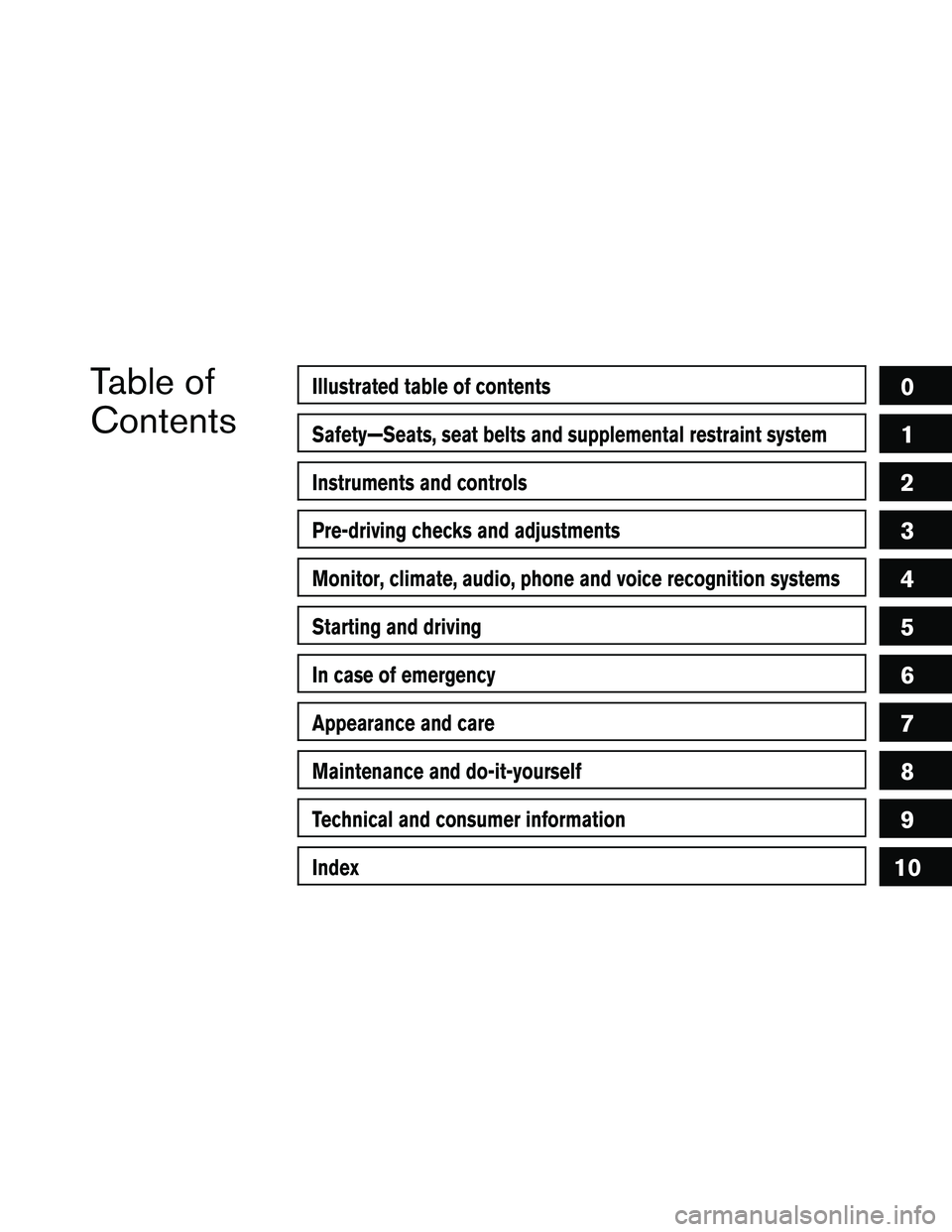
Table of
ContentsIllustrated table of contents
Safety—Seats, seat belts and supplemental restraint system
Instruments and controls
Pre-driving checks and adjustments
Monitor, climate, audio, phone and voice recognition systems
Starting and driving
In case of emergency
Appearance and care
Maintenance and do-it-yourself
Technical and consumer information
Index
0
1
2
3
4
5
6
7
8
9
10
Page 17 of 457
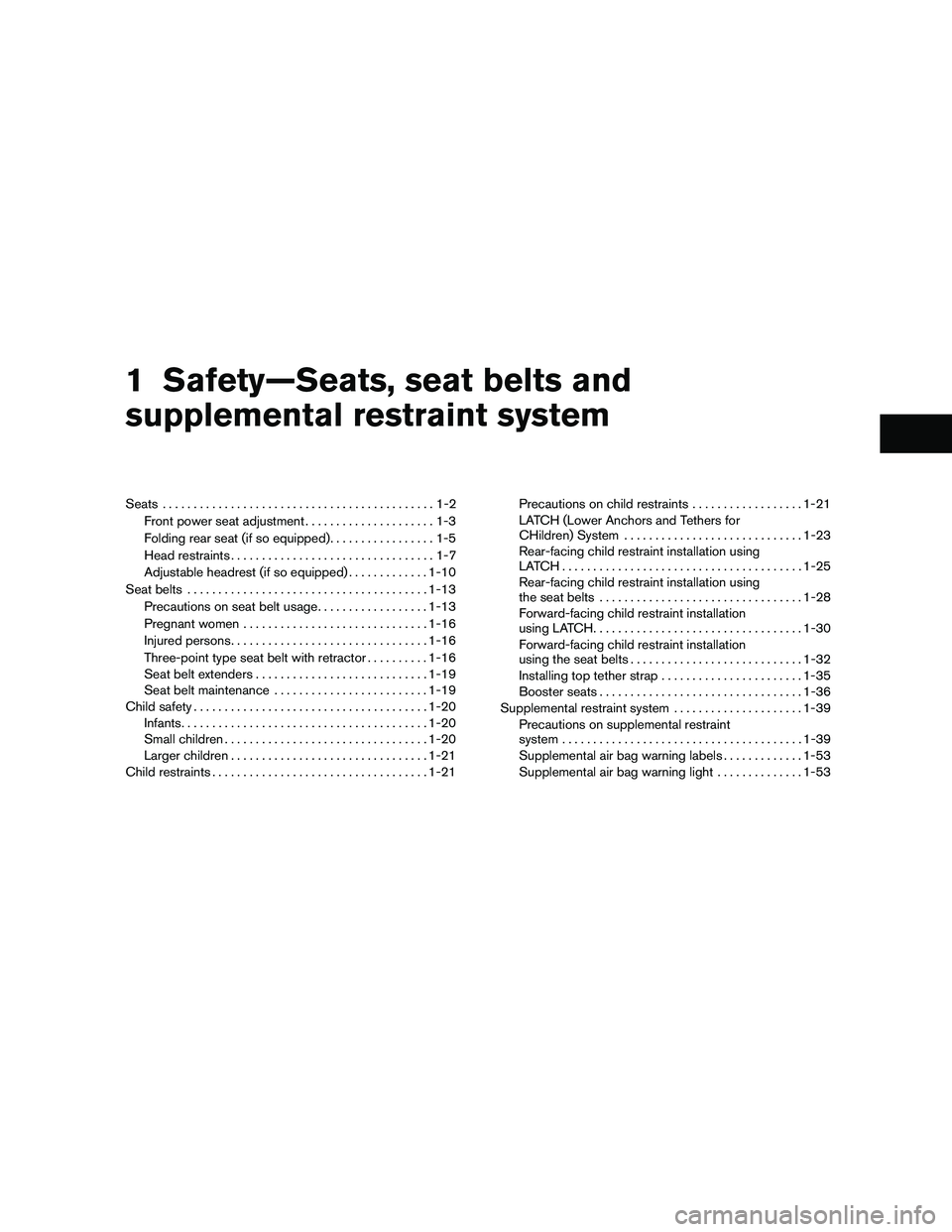
1 Safety—Seats, seat belts and
supplemental restraint system
Seats............................................1-2
Front power seat adjustment.....................1-3
Folding rear seat (if so equipped).................1-5
Head restraints.................................1-7
Adjustable headrest (if so equipped).............1-10
Seat belts.......................................1-13
Precautions on seat belt usage..................1-13
Pregnant women..............................1-16
Injured persons................................1-16
Three-point type seat belt with retractor..........1-16
Seat belt extenders............................1-19
Seat belt maintenance.........................1-19
Child safety......................................1-20
Infants........................................1-20
Small children.................................1-20
Larger children................................1-21
Child restraints...................................1-21Precautions on child restraints..................1-21
LATCH (Lower Anchors and Tethers for
CHildren) System.............................1-23
Rear-facing child restraint installation using
LATCH.......................................1-25
Rear-facing child restraint installation using
the seat belts.................................1-28
Forward-facing child restraint installation
using LATCH..................................1-30
Forward-facing child restraint installation
using the seat belts............................1-32
Installing top tether strap.......................1-35
Booster seats.................................1-36
Supplemental restraint system.....................1-39
Precautions on supplemental restraint
system.......................................1-39
Supplemental air bag warning labels.............1-53
Supplemental air bag warning light..............1-53
Page 18 of 457
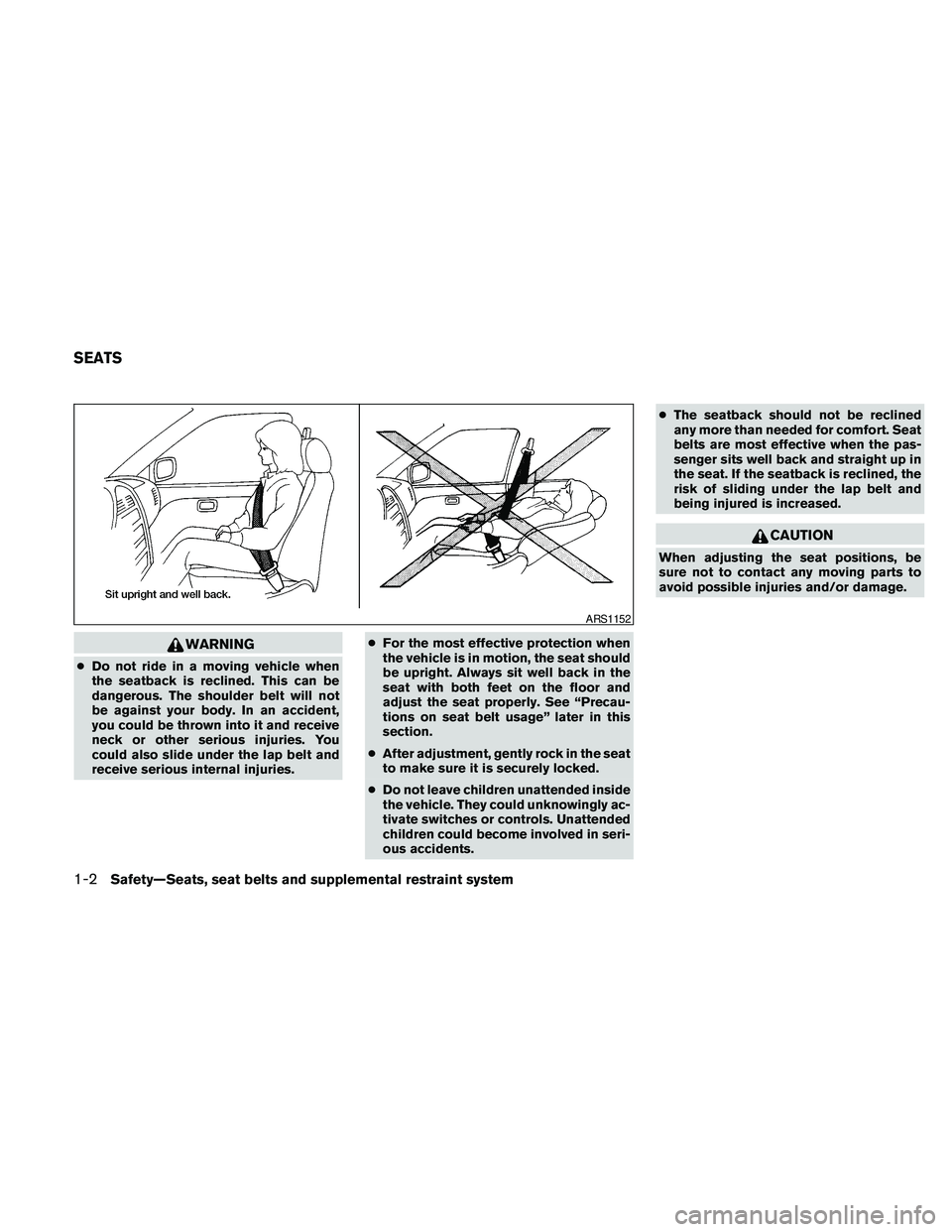
WARNING
cDo not ride in a moving vehicle when
the seatback is reclined. This can be
dangerous. The shoulder belt will not
be against your body. In an accident,
you could be thrown into it and receive
neck or other serious injuries. You
could also slide under the lap belt and
receive serious internal injuries.cFor the most effective protection when
the vehicle is in motion, the seat should
be upright. Always sit well back in the
seat with both feet on the floor and
adjust the seat properly. See “Precau-
tions on seat belt usage” later in this
section.
cAfter adjustment, gently rock in the seat
to make sure it is securely locked.
cDo not leave children unattended inside
the vehicle. They could unknowingly ac-
tivate switches or controls. Unattended
children could become involved in seri-
ous accidents.cThe seatback should not be reclined
any more than needed for comfort. Seat
belts are most effective when the pas-
senger sits well back and straight up in
the seat. If the seatback is reclined, the
risk of sliding under the lap belt and
being injured is increased.
CAUTION
When adjusting the seat positions, be
sure not to contact any moving parts to
avoid possible injuries and/or damage.
ARS1152
SEATS
1-2Safety—Seats, seat belts and supplemental restraint system
Page 19 of 457
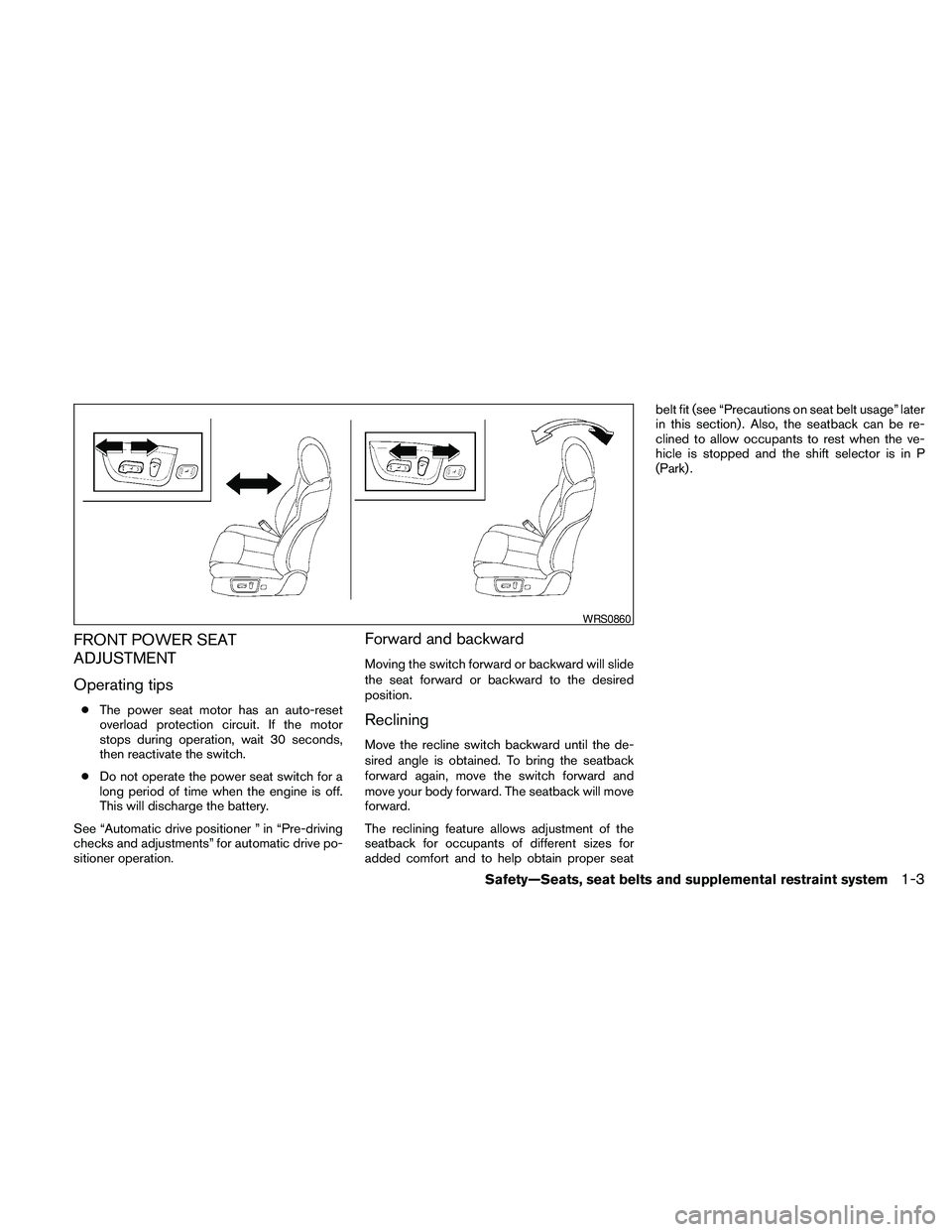
FRONT POWER SEAT
ADJUSTMENT
Operating tips
cThe power seat motor has an auto-reset
overload protection circuit. If the motor
stops during operation, wait 30 seconds,
then reactivate the switch.
cDo not operate the power seat switch for a
long period of time when the engine is off.
This will discharge the battery.
See “Automatic drive positioner ” in “Pre-driving
checks and adjustments” for automatic drive po-
sitioner operation.
Forward and backward
Moving the switch forward or backward will slide
the seat forward or backward to the desired
position.
Reclining
Move the recline switch backward until the de-
sired angle is obtained. To bring the seatback
forward again, move the switch forward and
move your body forward. The seatback will move
forward.
The reclining feature allows adjustment of the
seatback for occupants of different sizes for
added comfort and to help obtain proper seatbelt fit (see “Precautions on seat belt usage” later
in this section) . Also, the seatback can be re-
clined to allow occupants to rest when the ve-
hicle is stopped and the shift selector is in P
(Park) .
WRS0860
Safety—Seats, seat belts and supplemental restraint system1-3
Page 22 of 457
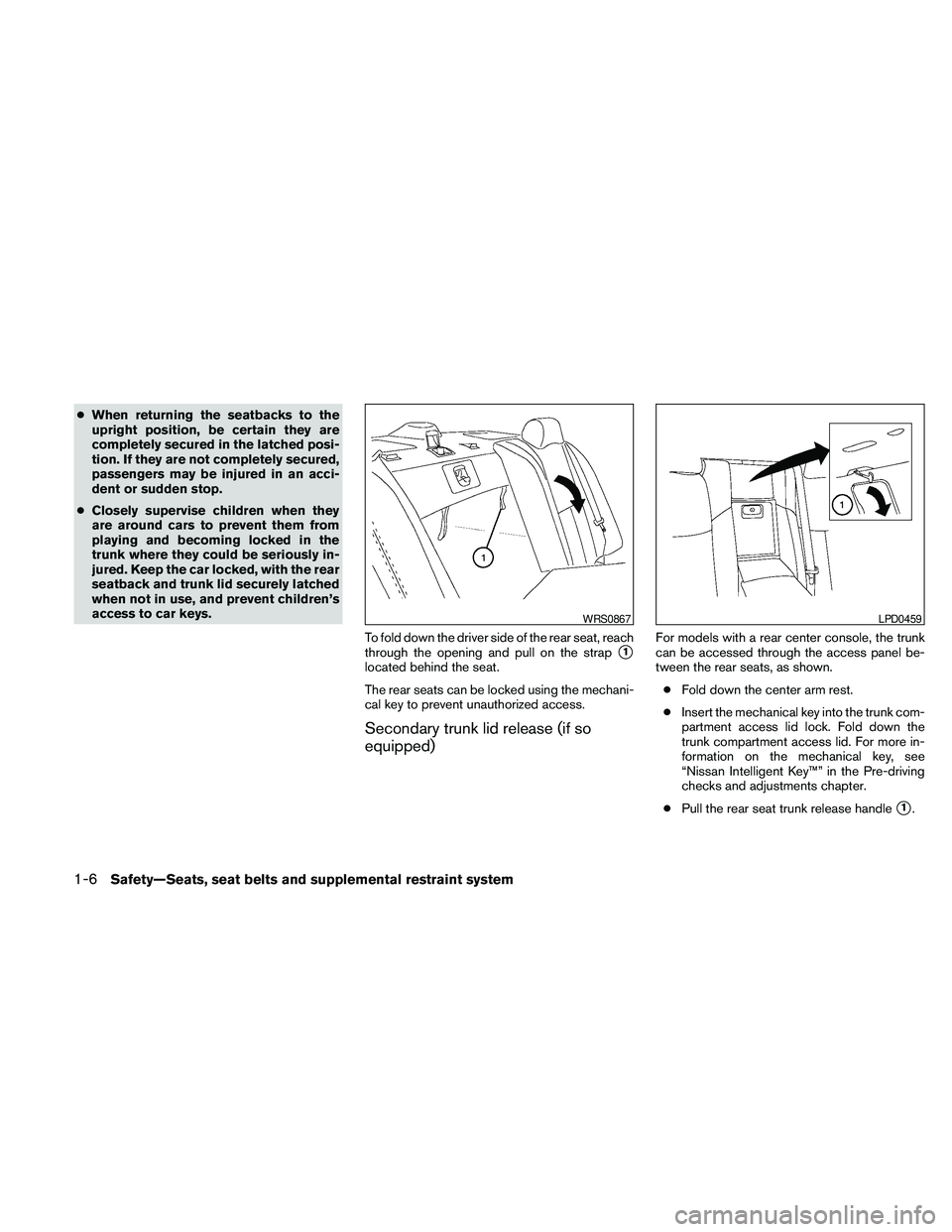
cWhen returning the seatbacks to the
upright position, be certain they are
completely secured in the latched posi-
tion. If they are not completely secured,
passengers may be injured in an acci-
dent or sudden stop.
cClosely supervise children when they
are around cars to prevent them from
playing and becoming locked in the
trunk where they could be seriously in-
jured. Keep the car locked, with the rear
seatback and trunk lid securely latched
when not in use, and prevent children’s
access to car keys.
To fold down the driver side of the rear seat, reach
through the opening and pull on the strap
s1
located behind the seat.
The rear seats can be locked using the mechani-
cal key to prevent unauthorized access.
Secondary trunk lid release (if so
equipped)
For models with a rear center console, the trunk
can be accessed through the access panel be-
tween the rear seats, as shown.
cFold down the center arm rest.
cInsert the mechanical key into the trunk com-
partment access lid lock. Fold down the
trunk compartment access lid. For more in-
formation on the mechanical key, see
“Nissan Intelligent Key™” in the Pre-driving
checks and adjustments chapter.
cPull the rear seat trunk release handle
s1.
WRS0867LPD0459
1-6Safety—Seats, seat belts and supplemental restraint system
Page 23 of 457
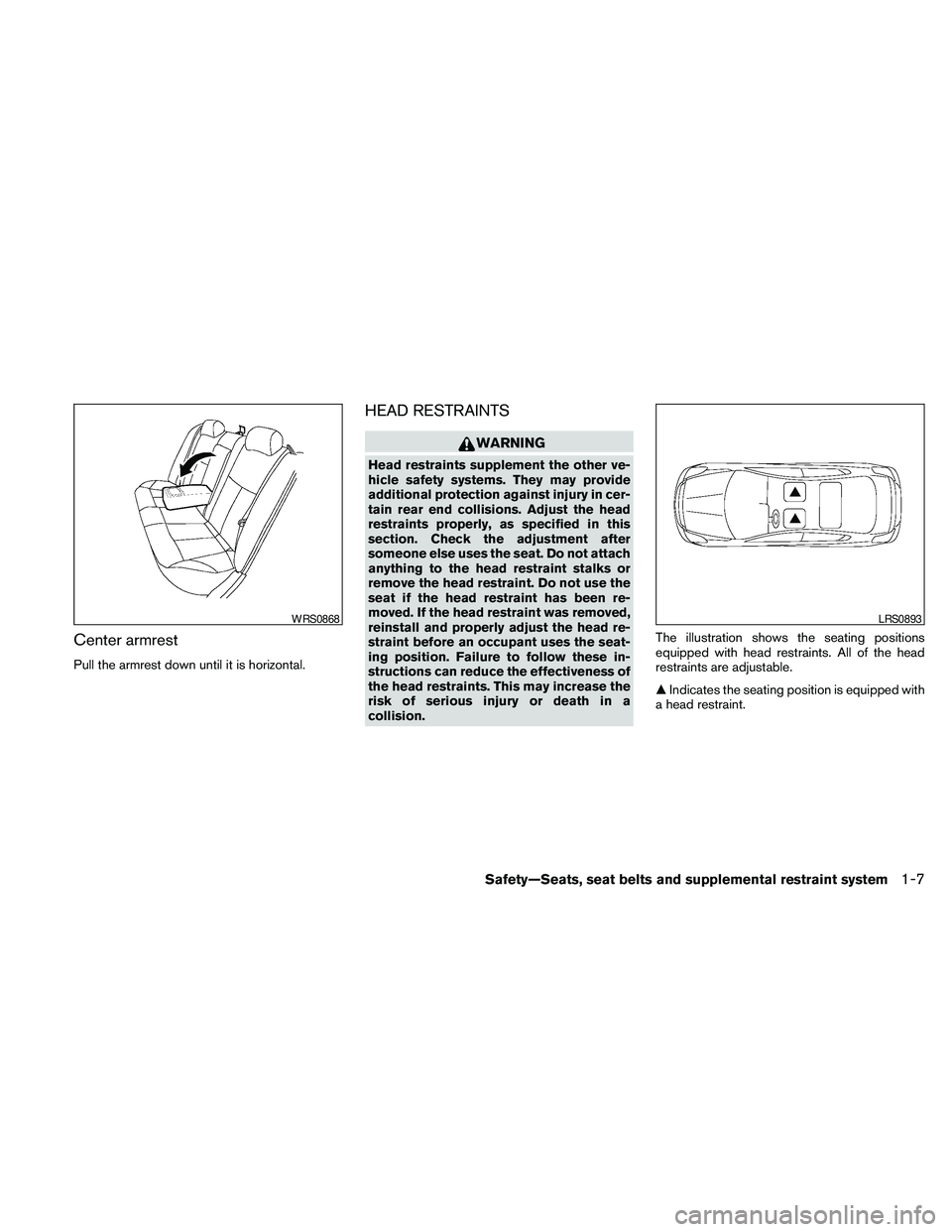
Center armrest
Pull the armrest down until it is horizontal.
HEAD RESTRAINTS
WARNING
Head restraints supplement the other ve-
hicle safety systems. They may provide
additional protection against injury in cer-
tain rear end collisions. Adjust the head
restraints properly, as specified in this
section. Check the adjustment after
someone else uses the seat. Do not attach
anything to the head restraint stalks or
remove the head restraint. Do not use the
seat if the head restraint has been re-
moved. If the head restraint was removed,
reinstall and properly adjust the head re-
straint before an occupant uses the seat-
ing position. Failure to follow these in-
structions can reduce the effectiveness of
the head restraints. This may increase the
risk of serious injury or death in a
collision.The illustration shows the seating positions
equipped with head restraints. All of the head
restraints are adjustable.
mIndicates the seating position is equipped with
a head restraint.
WRS0868LRS0893
Safety—Seats, seat belts and supplemental restraint system1-7
Page 24 of 457
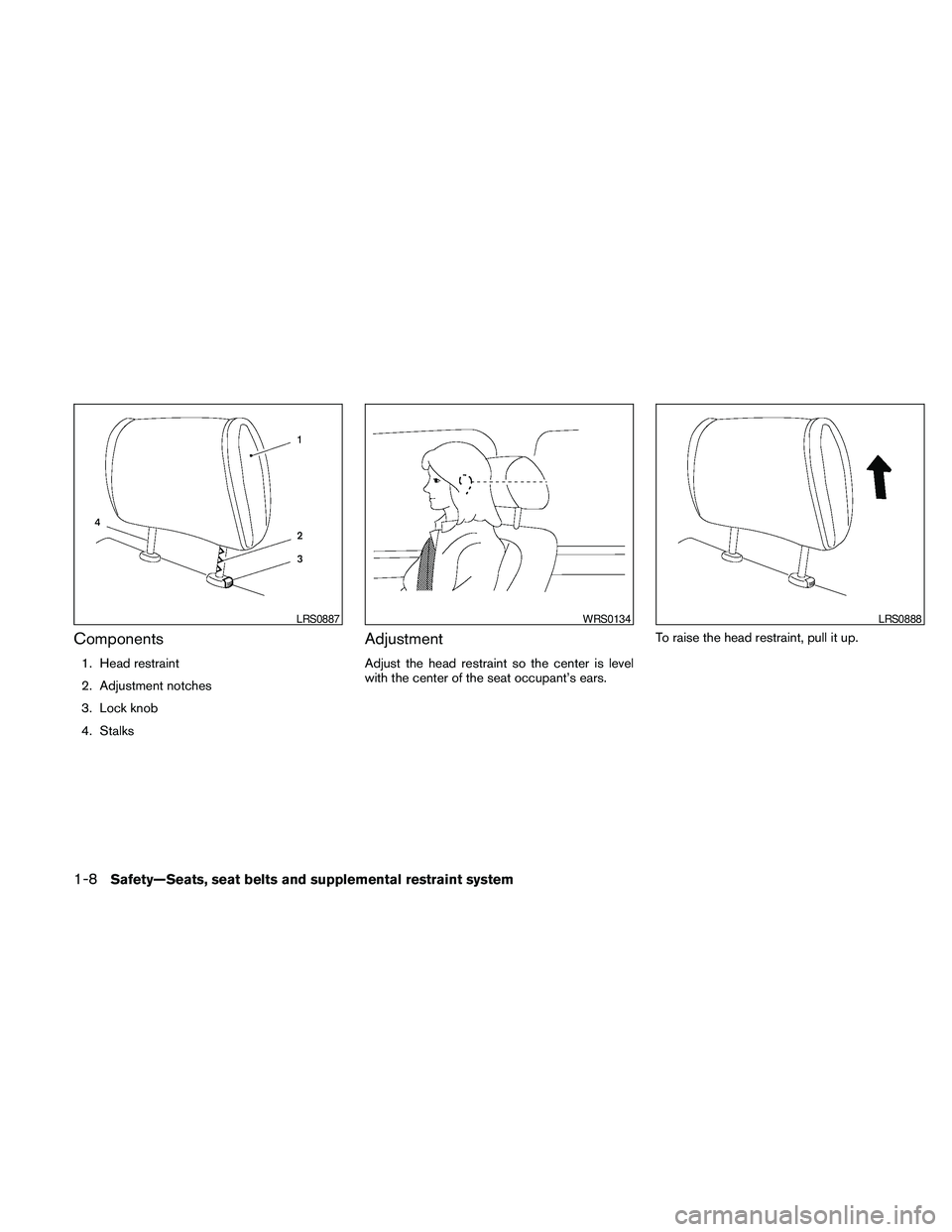
Components
1. Head restraint
2. Adjustment notches
3. Lock knob
4. Stalks
Adjustment
Adjust the head restraint so the center is level
with the center of the seat occupant’s ears.To raise the head restraint, pull it up.
LRS0887WRS0134LRS0888
1-8Safety—Seats, seat belts and supplemental restraint system
Page 25 of 457

To lower, push and hold the lock knob and push
the head restraint down.Removal
Use the following procedure to remove the ad-
justable head restraints.
1. Pull the head restraint up to the highest
position.
2. Push and hold the lock knob.
3. Remove the head restraint from the seat.
4. Store the head restraint properly so it is not
loose in the vehicle.
5. Install and properly adjust the head restraint
before an occupant uses the seating posi-
tion.
Install
1. Align the head restraint stalks with the holes
in the seat. Make sure the head restraint is
facing the correct direction. The stalk with
the adjustment notches
s1must be installed
in the hole with the lock button
s2.
2. Push and hold the lock knob and push the
head restraint down.
3. Properly adjust the head restraint before an
occupant uses the seating position.
LRS0889LRS0890LRS0891
Safety—Seats, seat belts and supplemental restraint system1-9
Page 26 of 457
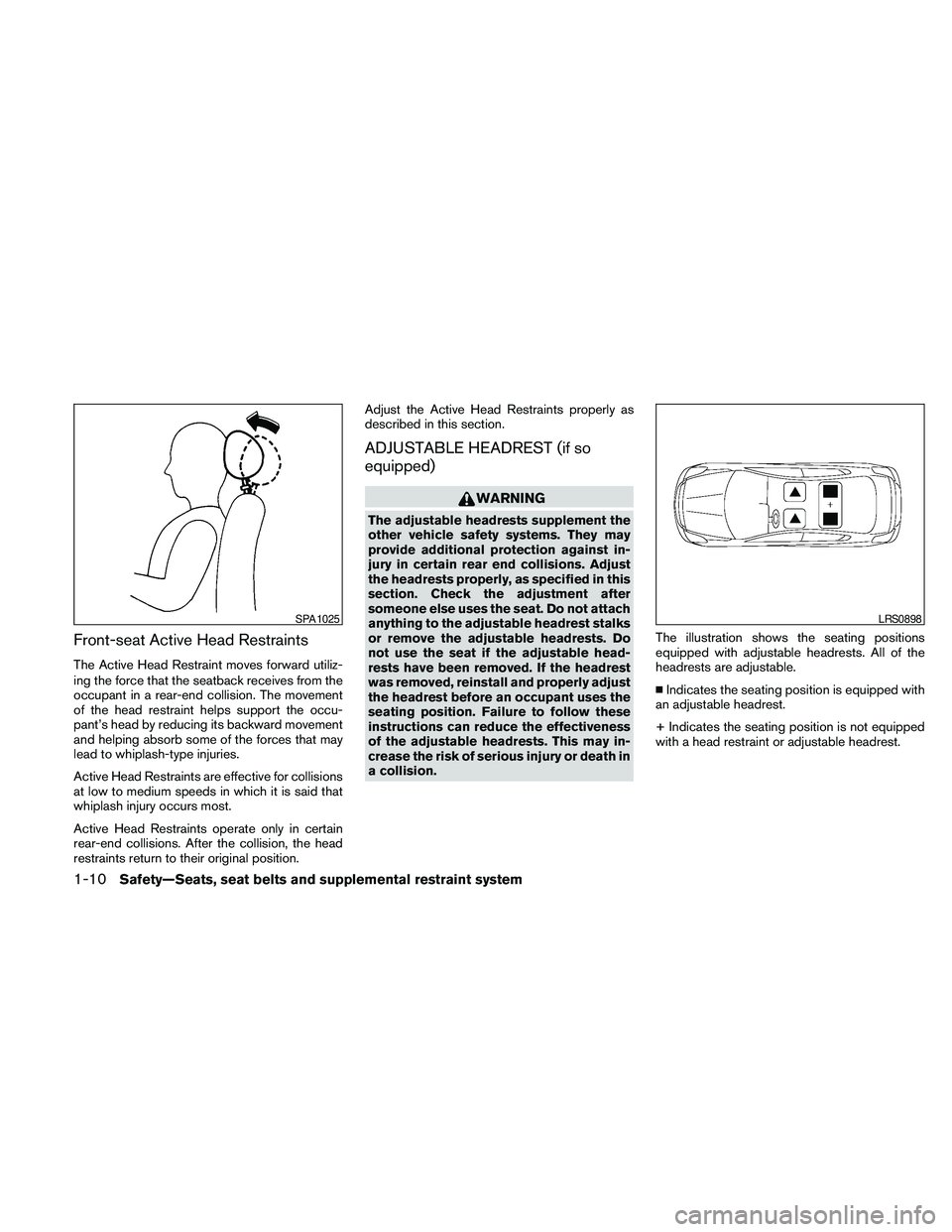
Front-seat Active Head Restraints
The Active Head Restraint moves forward utiliz-
ing the force that the seatback receives from the
occupant in a rear-end collision. The movement
of the head restraint helps support the occu-
pant’s head by reducing its backward movement
and helping absorb some of the forces that may
lead to whiplash-type injuries.
Active Head Restraints are effective for collisions
at low to medium speeds in which it is said that
whiplash injury occurs most.
Active Head Restraints operate only in certain
rear-end collisions. After the collision, the head
restraints return to their original position.Adjust the Active Head Restraints properly as
described in this section.
ADJUSTABLE HEADREST (if so
equipped)
WARNING
The adjustable headrests supplement the
other vehicle safety systems. They may
provide additional protection against in-
jury in certain rear end collisions. Adjust
the headrests properly, as specified in this
section. Check the adjustment after
someone else uses the seat. Do not attach
anything to the adjustable headrest stalks
or remove the adjustable headrests. Do
not use the seat if the adjustable head-
rests have been removed. If the headrest
was removed, reinstall and properly adjust
the headrest before an occupant uses the
seating position. Failure to follow these
instructions can reduce the effectiveness
of the adjustable headrests. This may in-
crease the risk of serious injury or death in
a collision.The illustration shows the seating positions
equipped with adjustable headrests. All of the
headrests are adjustable.
nIndicates the seating position is equipped with
an adjustable headrest.
+ Indicates the seating position is not equipped
with a head restraint or adjustable headrest.
SPA1025LRS0898
1-10Safety—Seats, seat belts and supplemental restraint system
Page 27 of 457
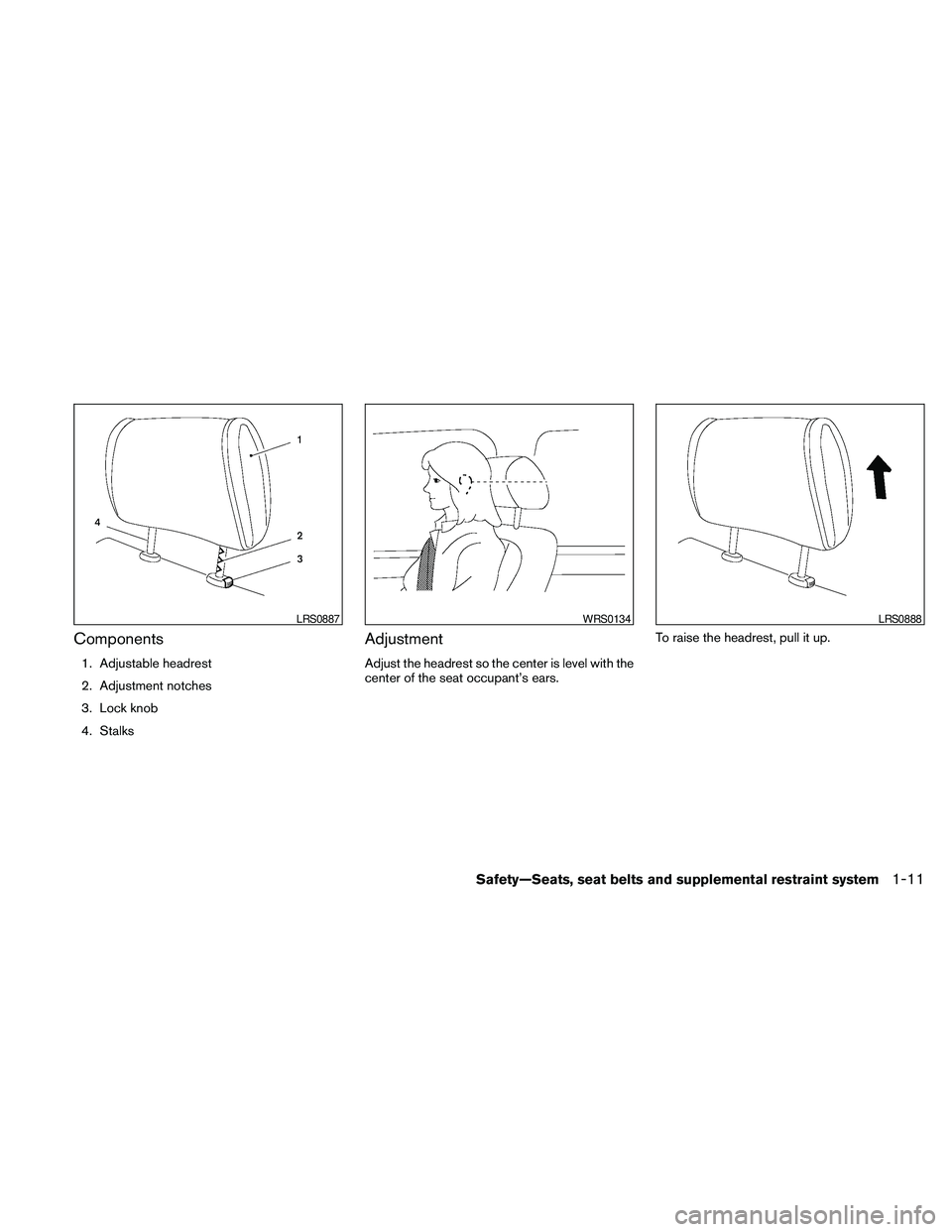
Components
1. Adjustable headrest
2. Adjustment notches
3. Lock knob
4. Stalks
Adjustment
Adjust the headrest so the center is level with the
center of the seat occupant’s ears.To raise the headrest, pull it up.
LRS0887WRS0134LRS0888
Safety—Seats, seat belts and supplemental restraint system1-11